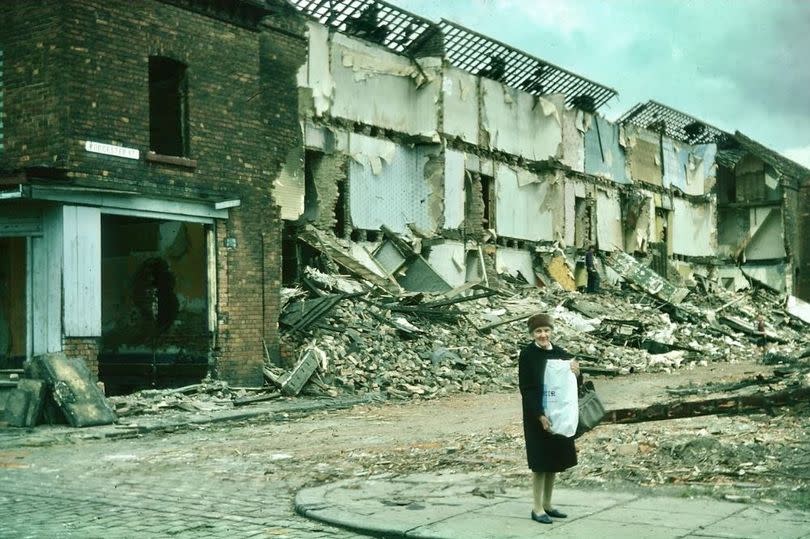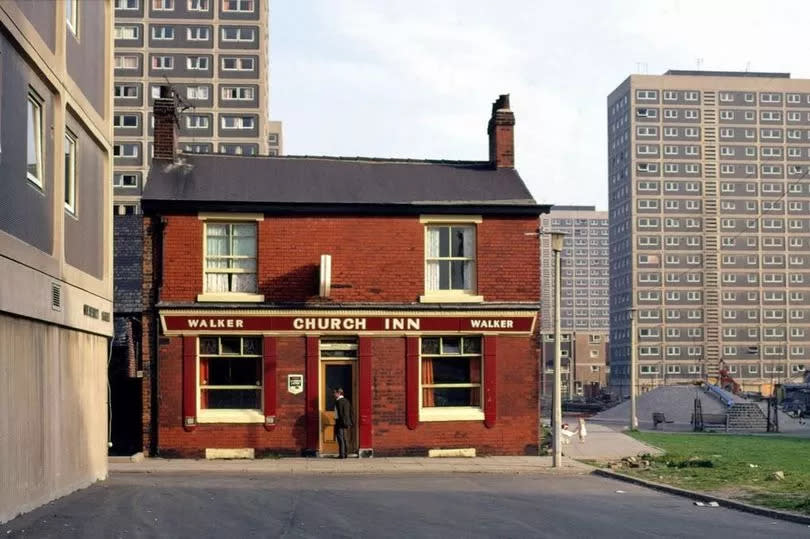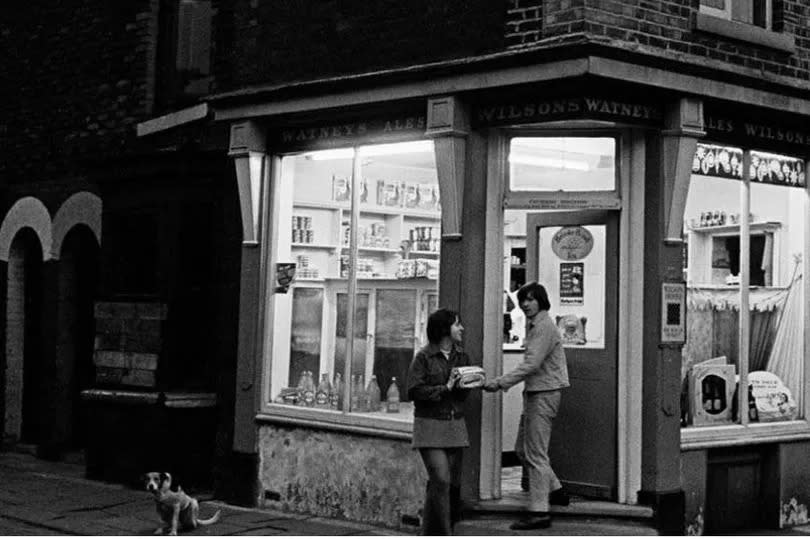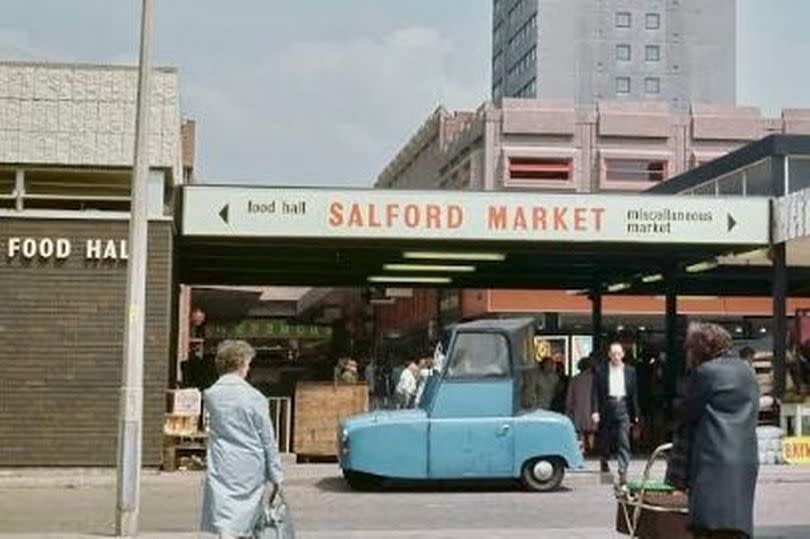It's now a thriving modern day city - but these striking photographs show it in a completely different light

Some would have graced the cover of a Smiths album perfectly. They capture a city in turmoil and the people living through it with grit and humour.
A tanned young woman in a classic pink dress with black going out shoes sweeping the cobbles of a Salford street with a broom in 1969. With her sixties-style big blonde hair she is beautiful and natural. But she was not posing - just cleaning outside her home with the Poet's Corner pub in the background of the Lower Broughton scene.
A pristine looking red-bricked Church Inn is pictured in Ellor Street in 1976. The traditional boozer proudly survives next to the city's brave new world - high rise blocks - and a plot of cleared land.
READ MORE: Stockport's oldest pub to reopen after lying vacant for over a decade

Pictured in atmospheric black and white a rain-drenched street in 1971 looking like a Coronation Street set with a solitary woman walking on a pavement shining from the downpour. A headscarf and heavy coat protect her as she clasps her purse.
The images are in an exhibition at Salford Museum and Art Gallery called "Invisible Cities". It focuses on the transformation of the city from 1952 to 1974 when terraced houses and neighbourhoods were being swept away and replaced with modern architecture.
Images taken and provided by local citizens, professional photographers, and stills from TV and film, alongside architectural drawings and illustrations are featured.

The exhibition is part of a University of Salford research project which explores the redevelopment of Salford and the changes that have taken place. The images show how its citizens documented their own history but also reveal how a modern Salford was planned by architects and town hall bosses as well as how its ‘slum clearance’ was captured by film and TV makers.
Dr Tanja Poppelreuter, an Associate Professor in Architectural Humanities at The University of Salford and the curator of the exhibition, said: “Salford has an important architectural history and has undergone significant changes in a short space of time. Its transformations are keenly remembered but it seems that several discreet histories exist side by side – that of the slum clearance, of modernisation, and that of living in densely populated neighbourhoods and of being rehoused. To this day, these histories evoke a range of emotions and memories.”
Nick Hedges, one of the photographers whose work features in the exhibition said: “It is such a democratic representative portrait of Salford. The mix of residents and professional contributions is truly vibrant. A great example of how history can be created to represent and embrace the reality of ordinary people’s lives.”
The exhibition juxtaposes private and professionally commissioned photographs, film and TV stills, architectural drawings, maps, memories, and statements from publications produced between 1952 – the year when the 20-Year development plan for Salford was published –and 1974 – when Salford’s city limits were expanded into a larger borough and the civic centre moved to Swinton.
Large parts of Salford, such as the Ellor Street Redevelopment Area, were redeveloped into modern quarters with tower blocks, maisonettes, and a shopping centre.

Houses were bought from private landlords by compulsory purchase and residents were rehoused in “overspill estates” like Little Hulton. Robert Matthew, Percy Johnson-Marshall and the Architectural Research Unit at the University of Edinburgh were commissioned to develop a master plan and modern accommodation.
By 1975 demolition was concluded, the redevelopment was partly completed, and citizens had been “rehoused.” The exhibition places images and text next to each other to ignite memories. The title of the exhibition is inspired by Italian journalist Italo Calvino’s 1972 book Invisible Cities.
Calvino who writes in the chapter “Cities and Memory”: "It is pointless to ask whether the new [places] are better or worse than the old, since there is no connection between them, just as the old postcards do not depict [the city of …] as it was, but a different city which, by chance, was called [the city of …], like this one."
Calvino explains that value is assigned to places that are lost and in the past. As a way to retain memories of this lost city of the past, imagery such as photographs, postcards, and maps, are used. They serve as incubators for our understanding of the past today.

The curators of the exhibition say: "The diverse nature of the images that are brought together in this exhibition and viewed as a whole might be able to generate different types of memories, reflections, and emotions than simply leafing through a family photo album, watching a TV series, classic film, or reading a book of architectural drawing and photography as isolated acts. It is in the juxtapositions of disparate types of images where this exhibition seeks to generate new meaning, insights and understanding."
The exhibition is organised into four chapters: Terraced Neighbourhoods, Architectural Utopia, Interstice, and Modern Living. They deliberately don’t try to provide a comprehensive overview to the history of slum clearance and redevelopment or attempt to offer an account of the housing conditions of Salford, or to analyse film and TV programmes set in Salford locations.
Images and captions contain information about the photographer, memories collected from local citizens, and the subject of the photograph.
The aim is to provide "interesting short insights into the aspirations of those planning the transformation of Salford the daily lives of citizens, or into the ways in which houses fell into disrepair and were demolished."

The Modern Backdrop was a two-year University research project that aimed to understand how planners, city council, and architects planned the slum clearance and redevelopment of Salford and the exhibition is the final part.
Two academic workshops and an international conference at the University brought together a broad range of perspectives from across the UK and Europe, and both scholars and local citizens took part in analysing how modern housing and its residents were depicted in a range of media.
At the same time, oral history interviews were done with longstanding Salford residents and a public screening of the classic Salford-based film A Taste of Honey, from the play written by Shelagh Delaney, was staged. Delaney did feature on the cover of the Smiths compilation "Louder Than Bombs".
A picture by Stanley Horrocks of a lady standing in front of half-demolished homes in Worcester Street in 1976 was provided by Paul Dyson. Horrocks documented the urban changes over long periods of time. The lady in the photograph lived near Mandley Park and seems to be on her way to or from Spencer’s Cleaning Centre on Great Cheetham Street. She knew Stanley and clearly enjoyed taking centre stage in the photograph.
In a tape-recorded conversation around this time the woman recalled being born in 1889 at Rhodes, near Middleton, starting work ten hours a day as a weaver when she was 11, getting married and family life in several places prior to living in Higher Broughton for nearly thirty years.
Two little girls playing against a cleared landscape is a picture of innocence. It shows "June and Joan" playing in a tin bathtub on the croft at Ellor Street after demolition had begun, around 1963. It was provided by June Pope. In the background are Pendleton Town Hall and under construction Walter Greenwood Court and Eddie Colman Court.
Tin baths were used all over Salford a the time. The photo was taken by a reporter who later gave the family a print of it. Older children and adults went to the public baths: One local recalled: “When I was a teenager in the 70s I had friends who lived in Ordsall. They used to have to go to Ordsall Swimming Bath to have a bath. They were too old to jump into a tin bath.”
A drawing of how Salford Precinct would look by architect is included showing the main pedestrian promenade linking the residential area to the shopping centre, dating from 1962.
A photograph by Mark Anthony Collinson, shows the Food Hall at Salford Precinct. The blue vehicle in the image is an “Invacar” (Invalid Carriage), a one-seat microcar for disabled drivers. It was distributed free of charge in the UK during the 1960s and 70s.

Nick Hedges, took the picture of the woman in the rain in a Salford Street, in 1971. He took it on the way back from interviewing and photographing a family living in “slum” housing. At the time, the charity, Shelter, for homeless people, was producing a report on the connection between bad housing and ill health.
Michael Goodger, photographed the woman in pink sweeping, in 1969. An artist, photographer and filmmaker and best known for his 1960s documentaries, The Changing Face of Salford, and Salford The Other Side on the clearance of the Salford slums that are regarded as being of major social importance.
As a young man, Michael joined the Liberal Studies department of the newly formed University of Salford where he taught painting, photography, and film. About this image Michael remembers “asking for (and obtaining) permission to take this photo, but, remarkably, it wasn’t posed or ‘done for the camera.’ This young woman really was sweeping the street outside her house as part of what I presumed was a regular routine, even though she looks more dressed up for a day out.”

He also took the picture of the Church Inn in 1976. When taking it Michael “was just struck by the juxtaposition of an old-fashioned pub surrounded by modern tower blocks.”
The exhibition is running until September 1st 2024 at the Salford Museum and Art Gallery, Peel Park, The Crescent, Salford M5 4WU. It was funded by the Paul Mellon Centre for Studies of British Art.
A spokeswoman for Salford Museum and Art Gallery said: "It has been great to see so many people coming to see the show, and bringing family and friends with them to share their memories across the generations. The mix of images from people’s own snapshots to film stills, to professional photographs and artefacts give a real insight into the changing landscape of Salford at this point in time."

 Yahoo News
Yahoo News 
